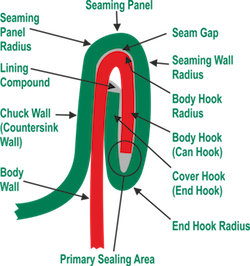Double Seaming Made Simple – Part 2

When it comes to metal cans, the ability to lock-in and preserve the freshness of ingredients, while also keeping out unwanted elements such as microorganisms and oxygen – is a big advantage. The double seam, found today on virtually all food and beverage cans is a simple and proven way to provide such a hermetic seal. In the following series, we'll outline a few key steps will lend you a better sense of how to achieve a fault-free seal.
Tip One: Understand the Double Seaming Terminology
The first thing you should do is get a firm understanding of the terminology of a double seam in order to grasp the process as a whole. A double seam creates a hermetic seal by interlocking the edges (flanges) both of the cover (lid or end) and body of the can. The body hook, which is also commonly known as the can hook, is the flange of the can body that is curled downward in the formation of the double seam. The cover hook, also called the end hook, is the curled edge of the cover that is curled inward after the end is formed.
Once you are familiar with the basic terms, you can explore the inner workings of the two operations. The first operation, or initial step in the formation of a double seam, occurs when the c-shaped profile of the seam roll is driven in to the cover hook causing it to be partially rolled up and under the flange of the can body. A suitable seaming chuck is used in conjunction with the seaming rolls, which acts as both a clamp to hold the cover in place during seaming, and as an anvil to support the cover as the seaming roll pushes against it to form the metal. The second operation is the final step in the formation of a double seam. During this process, the seam is further compressed and flattened against the side of the can body, resulting in a gas-tight seal. The results of the second operation are determined in the first operation. It is not possible to correct errors in the first operation by making adjustments to the second operation.
Watch out for the next entry in this series, where we will explore the first operation seal and discuss how to overcome common challenges.
